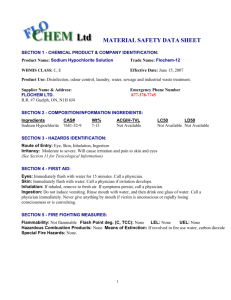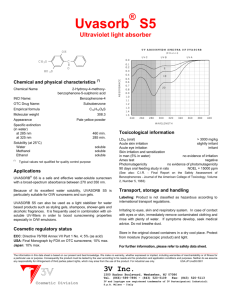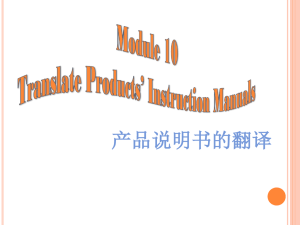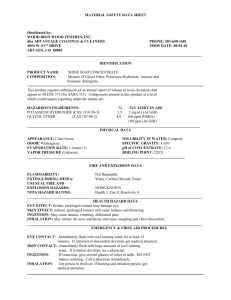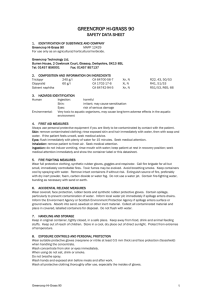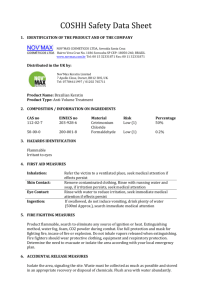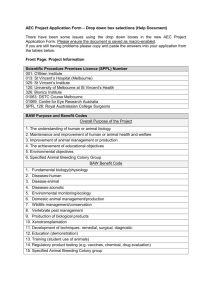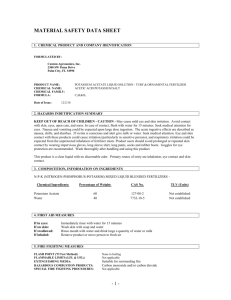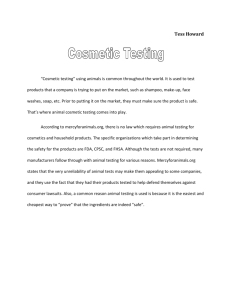Exaggerated exposure in topical irritancy and sensitization testing
advertisement
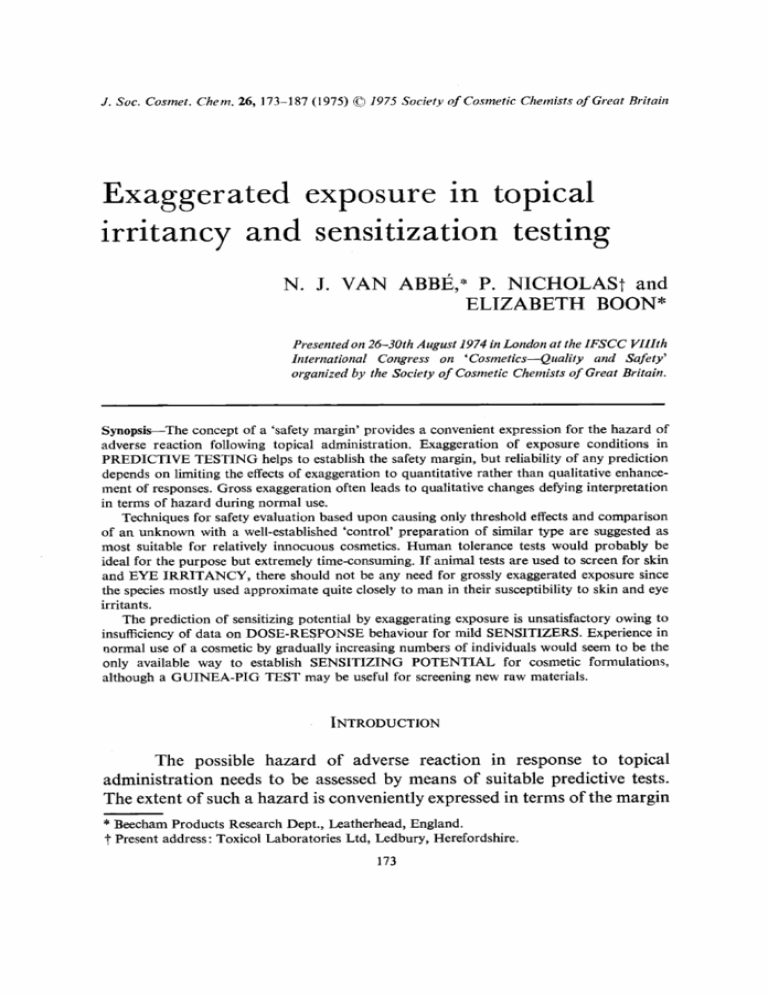
J. Soc. Cosmet.Chem. 26, 173-187 (1975) ¸ 1975 Societyof CosmeticChemistsof Great Britain Exaggeratedexposurein topical irritancyand sensitization testing N.J. VAN ABBI•,* P. NICHOLASI and ELIZABETH BOON* Presented on26-30thAugust1974in Londonat theIFSCC Vlllth International Congress on 'Cosmetics--Quality and Safety' organfled by the Societyof CosmeticChemistsof Great Britain. Synopsis--The conceptof a 'safetymargin'providesa convenientexpression for the hazardof adversereaction followingtopical administration.Exaggerationof exposureconditionsin PREDICTIVE TESTING helpsto establishthe safetymargin,but reliabilityof any prediction dependson limitingthe effectsof exaggeration to quantitativeratherthan qualitativeenhancementof responses. Grossexaggeration oftenleadsto qualitativechangesdefyinginterpretation in terms of hazard during normal use. Techniquesfor safetyevaluationbaseduponcausingonly thresholdeffectsand comparison of an unknown with a well-established 'control' preparation of similar type are suggested as most suitablefor relativelyinnocuouscosmetics.Human tolerancetestswould probably be idealfor the purposebut extremelytime-consuming. If animaltestsare usedto screenfor skin and EYE IRRITANCY, there shouldnot be any need for grosslyexaggeratedexposuresince the species mostlyusedapproximatequitecloselyto man in their susceptibility to skinand eye irritants. The predictionof sensitizing potentialby exaggerating exposure is unsatisfactory owingto insufficiency of data on DOSE-RESPONSEbehaviourfor mild SENSITIZERS. Experience in normaluseof a cosmeticby graduallyincreasingnumbersof individualswould seemto be the only availableway to establishSENSITIZING POTENTIAL for cosmeticformulations, althougha GUINEA-PIG TEST may be usefulfor screening new raw materials. INTRODUCTION The possiblehazard of adversereactionin responseto topical administrationneedsto be assessed by meansof suitablepredictivetests. The extentof sucha hazardis conveniently expressed in termsof themargin * BeechamProductsResearchDept., Leatherhead,England. •' Presentaddress:ToxicolLaboratoriesLtd, Ledbury,Herefordshire. 173 174 JOURNAL OF THE SOCIETY OF COSMETIC CHEMISTS between probable exposureof the skin or mucous membranesduring normal use and the level of exposure which would produce an adverse reaction.In order to err on the sideof safety,broad marginsof safetyare sought by exaggeratingthe levels and conditionsof exposurein the test procedures.However, injury may result from grosslyexcessivedirect contact of many tissueswith eventhe mostinnocuousenvironmentalchemicals and so a rational approachto exaggerationis essential. The degreeof chemicalinsult that the skin or mucousmembranesmight be expectedto tolerate is somewhatproblematical.The extensivetesting carriedout on the safetyof ingestedmaterials,suchasfood additives,offers little guidanceas suchinvestigations are principallyaimedat demonstrating toxic effectsafter systemicabsorption.The aspectof safetyevaluationfor ingestedsubstances correspondingto topical administrationis the direct effect, if any, of the test materials on the gastro-intestinallining. Severe irritation of the lining would indeedbe observedunder conditionsof gross exposureto many universally-accepted food materialsand especiallycondimentssuchasvinegarand mustard.In otherwords,althoughthereshould be a wide margin of toleranceoncea test material has beendiluted in the body fluids following absorption,a narrower margin is to be expectedin the case of a tissue in direct contact with the test material. Whilst acknowledgingthat thereare likely to be considerabledifferences betweendirect exposureand exposureafter absorption,it might be instructive to consider the postulateson which the safety evaluation of food additivesis based.A hundredfoldsafetyfactor (1) is commonlyquoted; this may be deemedto offer a tenfold allowancefor the greater susceptibility to systemictoxicantsof man comparedto laboratory animals, togetherwith a further tenfold allowancefor variationin susceptibility between individuals. In terms of systemictoxicity, such a tenfold allowancefor inter-speciesdifferencesin metabolic transformationand excretionseems reasonable. Effects on the skin and mucous membranes, however, are not primarily dependenton species-specific metabolicpathways.Indeed, the skin of thosemartahalsmost often usedfor irritancy testingapproximates quite closelyto human skin in its susceptibilityto irritation or even shows greatersensitivityto someirritants (2, 3). The epidermal horny layer of the skin is an important barrier to the absorptionof foreign chemicals(4) and providesthe first line of defence againstirritants.Thicknessof the horny layer variesacrossthe humanskin and in someregionsit is thinner than the horny layer of other mammals. However, human epidermis overall is much thicker (5) than in most EXAGGERATED EXPOSURE IN PREDICTIVE TESTING 175 mammals,includingthe rabbit, rat and mouse;this probablyexplainswhy appliedsubstances do not easilypenetratehumanskin (6) and why, on the whole,it is no more susceptible to irritantsthan is the skin of thesespecies. When irritancy testsare carried out on animal skin, it would thereforebe irrational to allow a tenfoldmarginfor interspecies differences. The possibleirritancy of cosmeticmaterials in contact with tissuesof the eye is usually studiedby instillation into the conjunctivalsac of the rabbiteye.On thebasisof wideexperience of suchtests,Davies(7) suggested that the rabbit eyewasdecidedlymore sensitiveto irritantsthan the human eye. Thus no allowance for interspeciesdifferencesseemsnecessaryfor extrapolatingrabbit eye test resultsin termsof hazard to man. A major factor involvedin selectingthe appropriatelevelsof exaggeration in irritancytestingis that a quantitativeenhancement of responses may help to establisha meaningfulsafetymargin, whereasa qualitativechange in the type of responsecould well renderthe findingsincapableof interpretation; qualitatively atypical responsesmight well result from gross exaggerationof exposurelevelsin testsfor skin and eye irritancy (Fig. 1). To ensurethat testingproceduresgive the information requiredfor safety assessment, a critical re-appraisalof currentmethodsis needed. TEST METHODS In the study of systemictoxicity, suitablyexaggerateddose-levelsare administeredto laboratory animalsin the diet, by gavageor by injection. Exposureof the skin or mucousmembraneto substantiallyexaggerated quantitiesof test material is seldom practical in the study of irritancy. Direct contact within a circumscribedarea is essential;an exaggerated quantityappliedto a largerareawill not necessarily intensifythe response. Exposureto a raw materialmay often be exaggerated by applyingconcentratedsolutions,but this would not be feasiblefor completeformulations. Even with raw materials,unrealisticeffectsmay occur,for example, owing to hypertonicityor grosslyabnormalhydrogenion concentration; suchexaggerationcouldwell produceeffectstotally irrelevantto the hazards of ordinaryuse,by producingqualitativeratherthan quantitativedifferences in response. An alternativeway of exaggeratingtopical exposureis to lengthenthe time of contactcomparedwith normal useor to make multiple applications. This is helpfulif it influencesthe responsequantitativelywithout provoking 176 JOURNAL OF THE SOCIETY OF COSMETIC CHEMISTS 2'5 -- 2.0 1.5 1.0 x x 0.5x-•X'" -•• 0 X50 XIO0 X300 0 X50 XIOOX300 0 X 'm=-- - X X50 XlOOX300 Estimated exaggerationof exposureto zinc pyridinethione •n shampoocompared with normal human usage Figure 1. Comparison of skin irritancy produced by repeated shampooing (,brokenlines) and occlusivepatch testing (solid lines). Breakage of the skin under occlusionsuggestsa qualitative changeindicating excessiveexaggeration. X, Erythema; O, breakage. *Scored according to Draize, J. H. (1959). Appraisal of the Safety of Chemicalsin Foods, Drugs and Cosmetics. a qualitativelydifferentskin reaction.An exampleof a qualitativelyaltered responsesometimesoccurswhen multiple exposuresto a moderateirritant lead to an enhanced'fatigue' response(8); this would be irrelevantin the studyof short-termhazards.Thus fatiguemay be pertinentto the safetyof a face creamfor daily usebut not to a hair-wavinglotion usedonly two or threetimesper year. Exaggerationby meansof multipleapplicationsshould thereforebe reservedfor testingsubstances intendedfor frequentlyrepeated topical use. Another method of exaggeratingexposurefor irritancy testing is to apply the test material to damagedskin, whichis more readilypenetrated by irritants than intact skin (9). Damage may be artificially inducedby abrasion,adhesivetape strippingor chemicalpre-treatment.Direct effects EXAGGERATED EXPOSURE IN PREDICTIVE 177 TESTING due to contactwith the underlyingtissues,however,may provemisleading if extrapolatedin termsof normalskin with an intacthornylayer. Certainly it is helpfulto knowwhatwill happenwhena productis appliedto damaged skin, but simple quantitativerelationshipsto irritancy for normal skin cannotthus be establishedand the distinctionneedsto be recognized. Chemicalpre-treatmentof the skin, for example,by applyingformaldehyde or sodium lauryl sulphate,may not producegrosslyvisible damage but will in many casesenhancepenetration.Usually the degreeof enhancement cannotbe quantifiedin termsof relativeirritancy to normal skin and the predictivevalue of a provocativetest usingchemicalpre-treatmentis thereforequestionable.Furthermore, the intensity of adverseeffectsmay be too severeto regard as reasonablyjustifiable for either animal or human studies. Sincethe variousmethodsusedfor exaggeratingexposureby inflicting damageto the skin in one form or anotherso often producedifficultyin interpretation, a rational conclusionis that such damage should never exceedthe minimumnecessary to ensurea detectableresponse;discrimination betweentestmaterialsin termsof skin irritancymay evenbe improved by limiting the overallresponse,e.g. by testingafter dilution of the product (Table I). Techniquesinvolvinggrosslyexaggerated exposurehave led to serious problemsof interpretationnot only in skin irritancy testingbut also in studiesof eye irritancy. For example,it has long beencustomaryto instil a Table I. Improved discrimination between irritancy of shampoosapplied to rabbit skin at 10% dilution Irritancy* after 5 h Type of shampoo Baby--based on amphoteric detergents Normal--based Neat 24h 10% Neat 10% 7 1.1 4 0 Erythema 1.5 1 2 0 Oedema 7 1.5 15 1.5 Erythema 8.5 I 14 0.5 Oedema 10.5 6 17 7.5 Erythema I 15.5 7 Oedema on anionic detergents Medicated--based ot• 0.5% Zn pyridinethione and anionic detergents 6 * Scoresaccordingto Draize (Group meansfor six rabbits). 178 JOURNAL OF THE SOCIETY OF COSMETIC CHEMISTS fixed quantity of undiluted test material into the conjunctivalsac of the rabbit eye without, as well as with, a subsequentrinse (10). The effects produced by instillation of undiluted material without rinsing may be qualitatively,as well as quantitatively,differentfrom the resultslikely to occurduringnormal useof the material. Consequently,productsare rarely if ever deemedunfit for human use becauseof severeeye irritation when tested under these grossly exaggeratedconditions in rabbits. A safety evaluationtest proceduregivingrise to severeeffectswhich are commonly and quite properly ignored,obviouslyhas little predictivevalue and no justificationin terms of the sufferingcausedto the experimentalanimals. A more meaningfulway of designingstudiesconcernedwith eye irritancy, as well as skin irritancy, is to employtest conditionsresultingin threshold or minimal irritation and to includea material with known irritancy in the studyto serveas a control.Wheneverpossible,the controlmaterial should be closelysimilarin chemicalstructureand mode of useto the testmaterial. Gaunt and Harper (11) reporteda procedurewherebyshampoodiluted to 10•o concentrationwas instilledinto the rabbit eye with no subsequent rinse. This techniqueavoidsgrosslyunrealisticexposurebut it would still be expectedto give someenhancementof irritant effectsby eliminatingthe rinsing procedure.As the authors acknowledgedand we have confirmed, their techniquehas the apparent disadvantageof militating against the recognitionof any tendencyto corneal or iridial injury (Table II), but it may nevertheless havebetterpredictivevaluethan a testin whichshampoo is instilledat 100•o concentration.Improvementsmight be madeby varying the shampooconcentrationto someextent or by giving duplicateinstillations(12). Table II. Rabbit eye test findingsshowingeffect of dilution of shampooswith water. Results at 10% dilution apparently gave better prediction of human response,no corneal or iridial injury having been notified as consumercomplaints 100% shampoo (no rinse) 10% shampoo (no rinse) Cornea Iris Conjunctiva Cornea Iris Conjunctiva 0 0 68 0 0 4 35 10 108 0 0 12 25 10 90 0 0 62 Non-medicated liquid shampoo Non-medicated cream shampoo Medicated cream shampoo Scoresaccording to Draize; each figure gives sum of scoresfor three rabbits after 1, 2, 3, 4 and 7 days. EXAGGERATED EXPOSURE IN PREDICTIVE TESTING 179 The questionablefeaturesof the more usual form of rabbit eye test, apply particularlyto its usein the evaluationof detergentingredientsand shampooformulations.For cosmeticproducts,however,normally used away from a washbasinand without rinsing, the instillation of undiluted productmay be more meaningfuland seldomleadsto grossinjury in the rabbit eye. A particulardifficultyin usinglaboratoryanimalsis the choiceof species and testing site for productssuch as dentifricescoming in contact with mucous membranesduring normal use. The hamster cheek pouch has sometimesbeen used for predictivetesting although the presenceof a cornifiedepitheliallining of the buccalmucosain this species may limit the sensitivityof the test. In view of the easeof handling of theseanimals and the relativelylarge area of tissueavailablefor examinationand biopsy, this seemsnevertheless to be the test of choiceat the presenttime; possible lack of sensitivitymay be overcomeby reasonableexaggerationof product concentrationand durationof contactwith the cheek pouch. The need to limit irritant effects in the course of tests on human volun- teersis obvious,to avoidcausingharm andto ensurecontinuingavailability of willingpanellists.It is alsohighlydesirableto maintainand, if possible, to improvestandardsin the humanitariantreatmentof laboratoryanimals and closeattention shouldbe given to the designof suitableprocedures both for humanand animal testing.The testsshouldpreferablynot, however, be designedin sucha way that they mostly lead to purely negative findings,sincetheseare as hard to interpretas grosslyabnormalpositive results;this is an additional reasonfor favouring a thresholdirritancy approach. Designsfor skinirritancystudiesbasedon thresholdirritation havebeen put forward by Kligrnan and Wooding (13). Theseauthorssuggested that findingsshouldbe recordedin terms of ID50 (concentration to yield threshold irritant effectin 505/0of test subjects)or IT50 (time of exposurefor thresholdirritation in 505/0of subjects).Choicebetweenthe two methods of expressingresultswould depend on the feasibility of testing diluted productand the level of irritancy of the test material.Whereasthe ID50 or IT50 principlemay be suitablefor evaluatingnewraw materials,formulated cosmetics will often prove altogethertoo bland for suchan approachand are more readilytestedby directcomparisonwith an appropriately-chosen control product. 180 JOURNAL OF THE SOCIETY OF COSMETIC CHEMISTS PATCH TESTING Skin irritancy is usuallyinvestigatedby meansof a patch testprocedure (!4); frequentlythis involvesthe application of test material to the skin with relatively prolonged occlusion under an impermeable or semipermeable dressing(Table III). Occlusion itself will produce minimal damage of the skin and a 'closed' patch test therefore embodiessome degreeof exaggeratedexposure. Table Ill. Occlusivity olr patch test materials expressedas drying time oœ hydrated CoCI2 paper on glassbacking, exposedat 19.5-4-1ø, 49.5 4-1.5% RH, beneath the patches,for pink ->- blue colour change Material Nil Mean drying time (min) 20 Gauze (only) Gauze+ blenderre-backedlint square Micropore+ lint square Micropore (only) Micropore+blenderm-backed lint square Dermicel + blenderm-backedlint square Dermicel (only) Blenderm (only) 45 65 80 155 200 230 390 1145 n• SD 7 6.3 6 6 6 7 7 6 7 7 7.8 8.4 6.3 6.3 33.0 21.0 8.4 43.0 Micropore: supplied by 3M Co, London. Dermicel: supplied by Johnson& Johnson Ltd, Slough. Blenderm: supplied by 3M Co, London. In the handsof an experiencedclinician, the occlusivepatch test is a valuabletechniquefor diagnosingthe causalagentsof pre-existingirritation and sensitization.Using occlusivetestingin a propheticmanner,however, involvesdifferent considerations.Some preparations(antiperspirants,for example)are normally used under conditionstantamount to occlusion; relevanceof an occlusivepatch test is then obvious.For many other products,e.g. face creamsand shampoos,occlusivepatch testsmay be somewhat lessrealistic.However, an occlusiveor partially occlusiveprophetic patchtestis probablythe bestavailableprocedurefor predictingthe effects of long-termexposureby meansof a relativelyshort-durationtest, taking into accountthe fact that many toilettiesand cosmeticsare usedrepeatedly over long periodsof time (Tables IV and V). Data showingquantitative results for occlusivevs non-occlusiveexposurein 21-day human patch tests(2) indicate that occlusiongivesa substantialenhancementof effect EXAGGERATED EXPOSURE IN PREDICTIVE 181 TESTING for many irritants. Skin irritancy testing carried out under 'open' patch test conditions(e.g. with the appliedmaterial under a loosely-wovengauze covering)might thereforebe preferablein order to avoid too many 'false positive' results. However, since toiletries and cosmeticsare invariably formulatedto give minimal skin reaction, 'open' patch testingin practice would nearly alwaysyield wholly negativeresultswhich would be hard to interpret. 'Closed'patch testsresultingin thresholdirritation, preferably including controls with known irritant potential, allow decisionson the acceptabilityof a cosmeticingredientor productto be reachedwith greater confidence. Another important considerationin patch testing concernsthe form and amount of test material applied.When a volatile solventis presentin the formulation, this shouldobviouslybe permittedto evaporatebefore a 'closed'patchis appliedto the skin; if this precautionis not taken, irritant effectsdue to the solventwill tend to give 'false positive'responses in the sensethat solventevaporationduringnormal usewould avoid any irritation from this source.A further complicationis that sometoiletry productsare Table IV. Detection of moderate increases in skin irritation, using partially occlusivehuman patch test (Uttley, M. and Van Abb6, N.J. J. Soc. Cosmet.Chem. 24, 217 (1973)) Product Irritancy score Nil (blank lint patch) 6.6* Lotion 6.6 base Base+ DHA (aged) Base+DHA (aged)+fresh DHA** Base (fresh)+ fresh DHA (10%) 8.4 9.3 10.9' DHA = Dihydroxyacetone. * Difference significantat 1% level (Wilcoxon). ** Adjusted to 10 •o concentration. Table V. Correlation betweenpartially-occlusivehuman patch test (Uttley and Van Abb6) and consumerreports Moisturizing cream Cheek gloss no. 1 Cheek glossno. 2 Cheek gloss no. 3 Irritancy Interpretation of score score 6.3' 11.0+ 12.6* 18.1 Non-irritant Slight irritant Slight irritant Moderate •- severe irritant * Significant at < 1% level (Wilcoxon). + Significant at < 2% level (Wilcoxon). Consumer reports No irritation No irritation No irritation Irritation 182 JOURNAL OF THE SOCIETY OF COSMETIC CHEMISTS rinsed off the skin during normal use soon after application. In these instances,loading a patch with the undiluted product and leaving it in contact with the skin at full concentrationfor many hours is highly unrealisticand may well prove intolerablefor the volunteers. For a shampoo,a more informativemethodof patchtestingis to apply the product to the patchesat a dilution of 10-20•o with water. When a physiologically-activeconstituent occurs in the formula (e.g. an antimicrobial agent) an alternative procedure is to load the patch with a quantitybasedon an amountper unit area of skinequivalentto the residue left on the scalpafter shampooing,as determinedby assay. Where the assay of actual residuespresentsseriousdifficulty, open patch testsmay be carried out by actually shampooinga small test area of skin daily for severaldays; experiencesuggeststhat this proceduremay evenhavebetterpredictivevaluethan a closedpatchtest basedon estimates of residualquantitiesafter rinsing. There shouldthus be no insuperabledifficultyin showingan adequate safetymargin for the topical administrationof cosmeticsand toiletriesby reasonableexaggerationof the exposureconditionsin testsfor irritancy. Since,for the reasonsalready stated,the presentauthorscontendthat no allowanceis usuallynecessary for interspecies variation,the choicebetween using human volunteersor laboratory animals does not appear to have great significancefrom the investigator'sstandpoint. If, however, the irritant potential of the test material really is unknown, initial screeningis certainly best carried out with laboratory animals. Moreover, if effectson damagedskin are being examined,an animal screeningtest is obviously desirablebefore extendingthe studyto human skin, as a reasonablesafeguard for the volunteers.Despite the similarity in responsesto irritants generallyshown,if interspeciesdifferencesare discerniblewhen resultsfor animal and human irritancy tests are compared, greater reliance should obviouslybe placedon the human data. To avoid uncertainty in extrapolation from animal responsesto man whilst minimizing the risk of seriousharm to volunteers,human studies may sometimestake the form of tolerancetests.The degreeof exposure (with respectto amount of test material applied, its concentrationor the duration of contact)is graduallyincreaseduntil a thresholdresponseoccurs. The predictivevalue of such a test shouldbe satisfactoryprovidedthat precautionsare takento avoidfatigueby carefulchoiceof siteof application or interval between applications.Human eye irritancy testing should generallyfollow this type of cautiousapproach(12). The drawbackto more EXAGGERATED EXPOSURE IN PREDICTIVE TESTING 183 widespreaduseof the humantolerancetest, however,is its time-consuming nature and the difficulty of recruitingvolunteers. SENSITIZING POTENTIAL Sensitizationis an important type of possible adverse reaction to toilettiesand cosmetics;it usuallyinvolvesthe risk of causingan allergic contact dermatitis and needsto be consideredseparatelyfrom irritancy. Allergensmay sensitizeoccasionalindividualsat concentrationswhich are without any significanteffecton the majority of the population;this feature of allergenicitycausesgreat difficultyin predictivetesting.Somedermatologistsnevertheless take the viewthat exposinga groupof randomly-chosen subjectsunder test conditionsto an exaggeratedconcentrationof a suspectedallergenincreases the chanceof recognizingits sensitizing potential. If so,what degreeof exaggeration is appropriate? Marzulli and Maibach (15) recentlyreporteda detailedinvestigationof sensitizingpropertiesusing exaggeratedconcentrationsof test materials. For example,with sorbicacid testedat 20•o concentration,one of the 33 subjectsthey testedgavea positivereaction.The crucialquestionis what proportionof users,if any, would be sensitizedat a typical use-concentration of about 0.1-0.2•o. Clearly this is unanswerablewithout knowing the shapeof the dose-response curvefor an allergenof the sameor a similar type, extendingright down to normal use-levelconcentrations of the test substance.These authors did, in fact, conduct testsat severalconcentration levelswith a number of compoundsbut the proportion of subjectswith positive responsesdid not show a dose-response pattern justifying any broad conclusions;a graded dose-response relationshipmay perhapsbe inferred on theoreticalgroundsbut eventhe extensivework carried out by Marzulli and Maibach (15) was evidently insufficientto demonstrateit clearly. Some toxicologistsconcernedwith toiletties and cosmeticsprefer to conducttests for sensitizingpotential at normal use-concentration of the test materials, using human volunteers.If such tests involve multiple exposuresunderocclusivepatches,the resultingminor degreeof skin damage shouldmarginallyincreasethe likelihoodof a positiveresponse.However, sinceit is well known that toilettiesand cosmeticsin generalsensitizeless than, say, 1 in 10 000 users,the predictivevalue of any use-concentration test carried out with only a few hundredvolunteersmust be exceedingly 184 JOURNAL OF THE SOCIETY OF COSMETIC CHEMISTS small. Selectionof atopic subjectsfor test panelsis sometimesconsidered to improvepredictivevalue but the evidenceto indicatethat atopicsshow enhancedsusceptibilityto topical allergensin generalis questionable(16). Bearing in mind the objectionsto grosslyexaggeratedexposuretesting and recognizingthat sensitizationtestingat normal use-concentration often yields negativeresultsthat cannot be interpretedor which may be unreliable,thereare certainattractionsin devisinga testprocedureto enhance responsesto use-concentrations and to ensure that positive results are obtainedevenwith moderateor mild sensitizers. Kligman (17) in proposing his 'maximization'test,offereda proceduregiving24/24 positiveresponses top-phenylenediamine eventhoughhe wasstillunableto detectsomeknown mild sensitizerssuchas lanolin. The value of this type of test for cosmetic evaluationdoesnot thereforeyet seemto have been established. At the present time, despitethe energeticattempts by a number of highly-skilledinvestigators,thereis clearlyno satisfactoryway of predicting the sensitizingpotential of cosmeticsand toiletries by means of human volunteerstudies;nevertheless, suchstudiescarry a definiterisk of sensitizing volunteers,possiblyfor someyears(18), and theirjustificationis therefore doubtful. As an alternative, a reliable test for sensitizingpotential usinglaboratory animalswould obviouslybe helpful. Whereas the responseof some other mammals closelyresemblesthe human responseto irritants, there are marked interspeciesdifferencesin allergicresponses. Suitabilityof the guinea-pigfor sensitization testinghas beenvalidatedto someextent(19) but it would be unwiseto expectguineapig studiesto eliminateany but the most potent sensitizers.Thus, although it is reasonablypracticalto testfor the sensitizing potentialof raw materials by conductingchallengetestsat elevatedconcentrationsusing animals or man, no comparableprocedureis yet available for studying complete formulationslikely to displayno more than mild sensitizingability. Rather than applying maximizing proceduresof dubious predictive value, it is probablybetterto allow a productto be usednormallyby graduallyincreasing numbersof individuals.This view takesfor granteda prior scrutinyof the raw materialsto eliminateany potentknown sensitizers and an adequate schemefor monitoring adversereactionsif they are reported by usersof the product. EXAGGERATED EXPOSURE IN PREDICTIVE TESTING 185 CONCLUSION Unreasonablecriteria for assessingthe potential hazards of topical administration do not necessarilyhelp to protect the consumer. Thus, although animal feedingtestson a proposedfood colour may well show that the maximum no-untoward-effectlevel is severalhundredtimesgreater than the expectedhuman intake, eventhe most harmlessmaterialsapplied to the skin with suchexaggerationare likely to prove injurious.Frazer (1) claimed that the acceptableusagelevel of a substance--hewas referring specificallyto food additives,thoughothershave appliedhis conceptmore widelymshouldbe regardedas one-hundredthof the level requiredto producesignificantmodificationof structureor functionin not more than 50•o of a group of test animals.Further, at a dose-levelequal to one-tenthof the ED50, no significantchangesof any kind should occur. Suchmargins, however,could not be applied generallyto substances coming in contact with the skin or mucousmembranes.For example, none of the synthetic anionicsurfactantswouldbe acceptableif a shampoohad to be formulated with no more than one-hundredthof the detergentconcentrationgiving threshold irritationin a closedpatchtest.Nevertheless, present-day shampoos are used almost universallywith minimal known adverseeffect; a differentbasisfor judging acceptabilityis thereforeneededand one of the possibleapproachesmight be to seek a tenfold margin in relation to experimentalfindingsto allow for individual differencesin susceptibility. As already shown, no allowancefor interspeciesdifferencesneed usually be made in irritancy testing.A tenfold safetycriterion on theselines may prove quite helpful for the safety evaluation of raw materials but it will seldom be a technicallyfeasible criterion for use in testing formulated products.Direct comparisonof a newly-formulatedproductin a threshold irritancy test with other formulationsof similar type, whoseeffectsduring normal use are known, will be more appropriate.Such a comparisonwill certainly give practical guidanceon probable safety-in-use.A study on human volunteerswill clearly be the most reliable and ideally the study shouldtake the form of a comparisonwith a known 'safe' and a known 'unsafe'material of similartype (i.e. with 'negative'and 'positive'controls). Comparisonwith a 'positive'control(e.g. a known irritant) might facilitate quantitativeexpressionof the findings,if a human tolerancetest is carried out. In circumstances where laboratory animal studiesare judged to be required,it will be equallydesirableto conducttheseas thresholdirritancy tests to forecast the onset of hazard to man in normal use. 186 JOURNAL OF THE SOCIETY OF COSMETIC CHEMISTS Reasonablyexaggeratedexposurein cosmeticsafety evaluation may theoreticallybe achievedby designing'in use' tests.Human volunteersuse the test material for a few weeks with more frequent applicationsthan would normally be made and subjectto repeatedexaminationfor adverse effects.Such a proceduremay involve a risk that the investigatorwill be unableto control the amount and frequencyof applicationeffectivelyand that comparisonswith suitablecontrolsmay be difficult to arrange.Unless the conditionsof testingprove suitablefor achievingthresholdresponses, interpretationmay dependon negativefindingswhich will limit the reliability of the study.'In use'testingwarrantsseriousconsideration,however, as an alternativeto the highly empirical, grosslyexaggeratedprocedures currentlyfavoured by someinvestigators. ACKNOWLEDGMENT The authorsare indebtedto Mr J. Brown for the data given in Table11I. (Received:loth April 1974) REFERENCES (1) Frazer, A. C. Pharmacological Aspects of Chemicals in Food. Endeavour12 43 (1953). (2) Phillips,L., Steinberg,M., Maibach, H. I. and Akers, W. A. A comparisonof rabbitand human skin responseto certain irritants. ToMcol.Appl. Pharmacol.21 369 (1972). (3) Yankell, S. L. Animal studiesas predictersof skin irritants. CTFA Cosmet.J. 4 8 (1973). (4) Malkinson, F. D. Studieson the percutaneousabsorptionof C '4 labelled steroidsby use of the gas-flow cell. J. Invest. Dermatol. 31 19 (1958), (5) Spearman,R. I. C. TheIntegument125 (1973) (CambridgeUniversityPress,London). (6) Bartek, M. J., La Budde,J. A. and Maibach, H. I. Skin permeabilityin vivo: comparison in rat, rabbit, pig and man. J. Invest. Dermatol. 58 114 (1972). (7) Davies, R. E. Toxicologicalappraisal of cosmetics.Soap,Perrum.Cosmet.40 887 (1967). (8) Finkelstein, P., Laden, K. and Miechowski, W. New methods for evaluatingcosmetic irritancy. J. Invest. Dermatol. 40 11 (1963). (9) Freeman, M. V., Alvarez, E. and Draize, J. H. Cutaneous absorption of phenol from intact and damagedskin. Fed. Proc. 9 273 (1950). (10) Draize, J. H., Woodward, G. and Calvery, H. O. Methods for the study of irritation and toxicity of substancesapplied topically to the skin and mucousmembranes.J. Pharmacol. Exp. Therap.82 377 (1944). (11) Gaunt, I. F. and Harper, K. H. The potential irritancy to the rabbit eye of certain commercially availableshampoos.J. Soc. Cosmet.Chem.15 209 (1964). (12) Van Abb6, N.J. Eye irritation: studiesrelatingto responsesin man and laboratory animals. J. Soc. Cosmet.Chem. 24 685 (1973). (13) Kligman, A.M. and Wooding, W. M. A method for the measurement and evaluation of irritants on human skin. J. Invest. Dermatol. 49 78 (1967). EXAGGERATED EXPOSURE IN PREDICTIVE TESTING 187 (14) Uttley, M. and Van Abb6, N. J. Primary irritation of the skin; mouseear test and human patch test procedures.J. Soc. Cosmet.Chem. 24 217 (1973). (15) Marzulli, F. N. and Maibach, H. I. Antimicrobials:experimentalcontactsensitizationin man. J. Soc. Cosmet.Chem.24 399 (1973). (16) Hardy, J. Allergy, hypersensitivity and cosmetics.J. Soc. Cosmet.Chem.24 423 (1973). (17) Kligman, A.M. The identificationof contactallergensby human assay.III. The maximization test: a procedurefor screeningand rating contactsensitizers.J. Invest.Dermatol. 47 393 (1966). (18) teLintum, J. C. A. and Nater, J.P. On the persistenceof positivepatch test reactionsto balsamof Peru, turpentineand nickel. Brit. J. Dermatol. 89 629 (1973). (19) Maguire, H. C. Jr. The bioassayof contactallergensin the guinea-pig.J. Soc. Cosmet. Chem. 24 151 (1973).
